Twentieth Century Ships Binnacle Salemans Sample By Kelvin & Hughes Limited
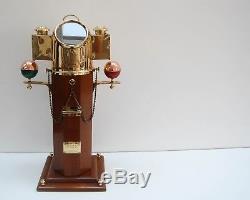

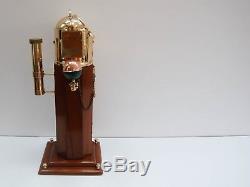
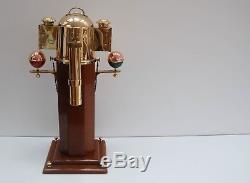
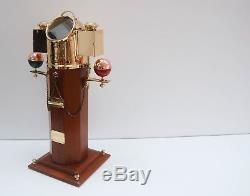
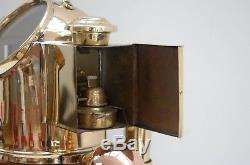

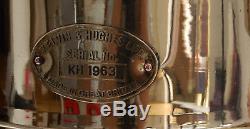
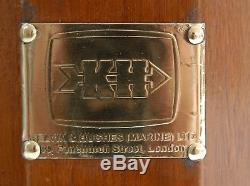
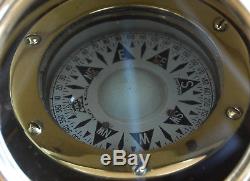


For sale, a rare twentieth century scaled down salesmans sample of a Kelvin & Hughes ships binnacle compass. This superb and somewhat more manageable example of a ships binnacle compass is comprised of all the same materials as its working counterpart.
The octagonal base is teak with typical red and green correcting sphered either side, (these are not formed of iron but are decorative examples), it also has a flinders bar container attached to the back. The brass hood has a single glazed viewing window to the front, carry handle to the top and a receptacle with hinged door either side containing a paraffin lamp to light up the compass when dark. The four inch dial compass is contained within a working gimbal and comes complete with a Kelvin & Hughes marked compass card. Samples such as these are rare to appear on the market and would have been provided to sales staff from the company as a visual aid for their endeavours. Examples by Sestrel are also known to have been produced and they make interesting and far more manageable alternatives to their larger working counterparts.
A rare and exceedingly interesting artefact from a company with a long and varied history. The binnacle measures: H:60 x W:37 x D:28 cms.
Both Kelvin, Bottomley & Baird and Henry Hughes in their numerous forms were long famed for their production of scientific instruments and the amalgamation of these two companies into Kelvin Hughes continues to be an important provider to the maritime industry today. The maker Henry Hughes founded his business in 1828.
Noted for its life size wooden figure of a seaman with sextant displayed outside the front door, Hughes premises at Fenchurch Street was a popular destination for merchant and Royal Navy seaman and Hughes gained much business from the Admiralty in the nineteenth century due to the quality and precision of his instruments. The business was incorporated as Henry Hughes & Son Ltd in 1903 and ran successfully until its premises were destroyed during the blitz in 1941. The same fate had also occurred to the premises of Kelvin, Bottomley & Baird. Kelvin, Bottomley & Baird originated in Glasgow and began as a partnership between Professor William Thomson of Glasgow University and James White a Glaswegian instrument maker when White began to produce equipment for Thomsons laboratory at the University. The following twenty five years saw White form a short-lived partnership with John Barr (1857 1860) with a declaration of bankruptcy shortly after in 1861 but by the 1870s his long partnership with Thomson was maintained and he continued to produce instruments of Thomsons design which included the production of accurate compasses for metal ships and sounding machinery associated with the laying of the first trans-Atlantic cables. Thomson was himself a director of the Atlantic Telegraph Company and took an active part in the attempts, he was knighted in 1866 by Queen Victoria for his work in engineering and physics, becoming Baron Kelvin of Largs. White died in 1884 but continued under the stewardship of Matthew Edwards and David Reid and new workshops were constructed in Cambridge Street to support the manufacture of Thomsons compasses and supply to the Admiralty. It continued under Whites name until 1900 when the company was finally bought out by Thomson (Lord Kelvin) to become Kelvin and James White Ltd. Both Kelvin and his nephew, James Thomson Bottomley were listed as Directors of the newly formed organisation. Premises in London were later opened in London under the name of Kelvin, White & Hutton Limited (presumably incorporating Huttons London business) but by 1913, the company finally became Kelvin, Bottomley & Baird Limited. Kelvin had died by 1907 so it is likely that his nephew (now the chairman) was keen to be included in the company name and Alfred Baird, the firms compass adjuster who had been with the original company since 1884 had proved capable enough to rise to part owner. Their catalogues show that they were still making commercial success of their founders inventions, advertising various Kelvin patents such as the compass and the telegraph sounding equipment already mentioned. Trading continued until their London premises were (as mentioned above) also completely destroyed during the Blitz of 1941 and discussions with Henry Hughes Limited lead to a joint venture named, Marine Instruments Ltd based at new premises on Fenchurch Street.The new joint success of this collaboration lead to their amalgamation in 1947 becoming Kelvin & Hughes and by 1951 were operating independently under Smiths Industries Limited. Jason Clarke Antiques are happy to discuss carriage, condition or for any other queries, alternatively, you can also message me and I will endeavour to come back to you as soon as possible. I have a number of beautiful antiques for sale, so please feel free to browse my other items.
The item "TWENTIETH CENTURY SHIPS BINNACLE SALEMANS SAMPLE BY KELVIN & HUGHES LIMITED" is in sale since Thursday, November 15, 2018. This item is in the category "Antiques\Marine/Maritime". The seller is "jason750_1" and is located in newbury, Berkshire.This item can be shipped to United Kingdom.
- Maker: Kelvin & Hughes
- Object Type: Binnacle
- Primary Material: Brass
- Country/Region of Origin: United Kingdom
- Original/Reproduction: Vintage Original

